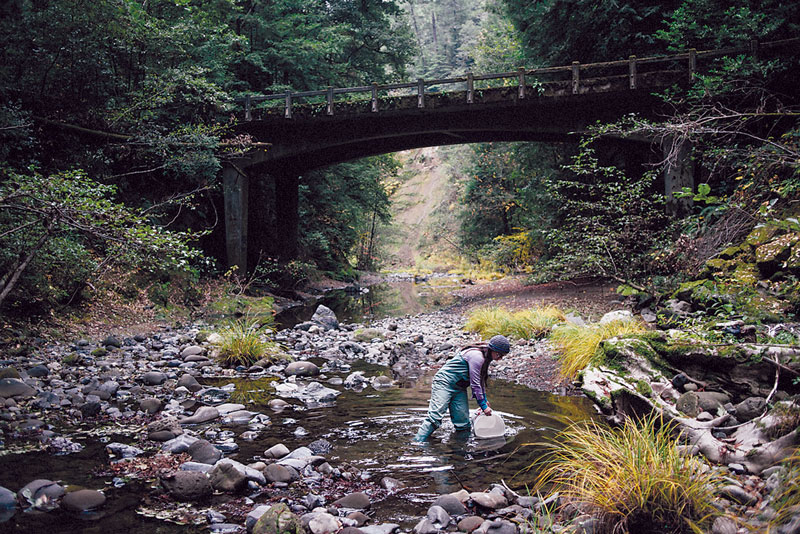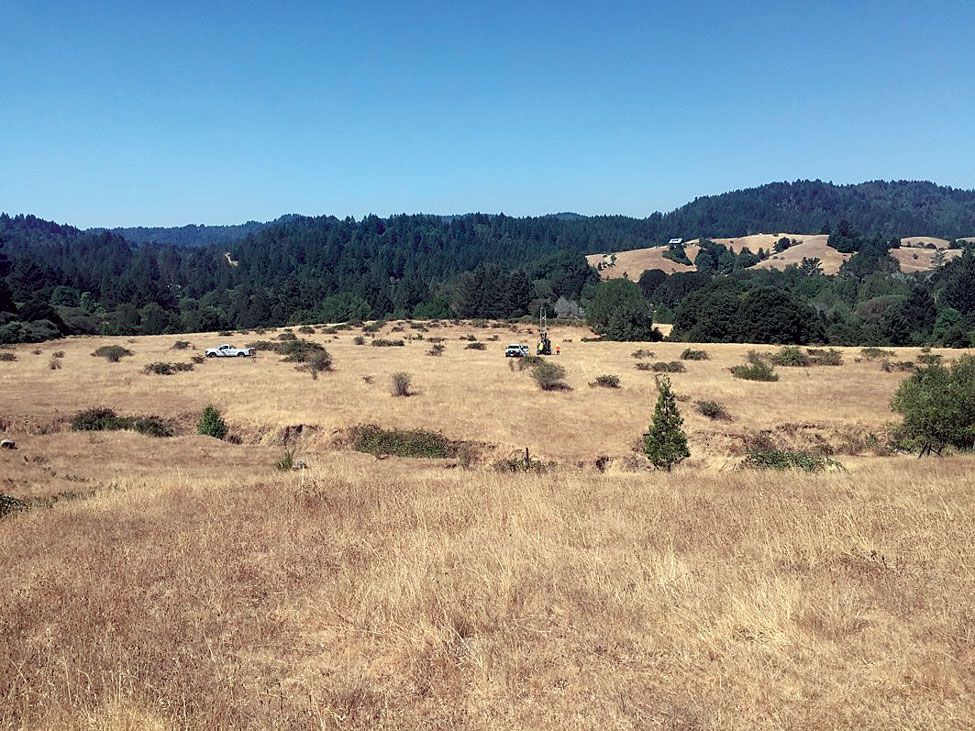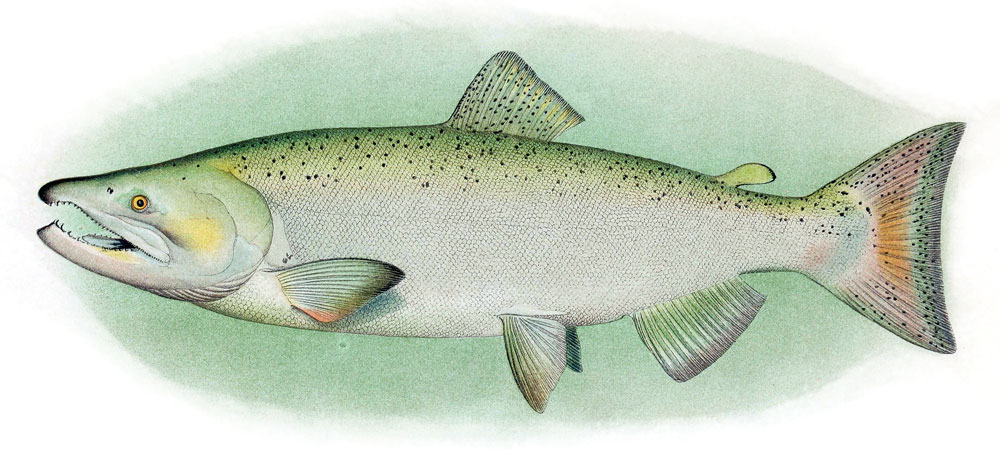Redwood Creek Flow-Enhancement Efforts Focus on the Marshall Ranch

By Salmonid Restoration Federation
Since 2013, Salmonid Restoration Federation has been conducting low-flow monitoring in Redwood Creek, a critical tributary to the South Fork Eel River. With funding from the Wildlife Conservation Board and the California Department of Fish and Wildlife, SRF and Stillwater Sciences have been exploring the feasibility of various streamflow enhancement opportunities in Redwood Creek. Stillwater Sciences conducted a feasibility study in a segment of the watershed that helped to identify priority projects that could improve summer flows. The company prepared conceptual designs for off-channel rainwater catchment ponds that could improve water security for individual parcels but would require wide and coordinated participation in order to measurably improve flows. After much research and reconnaissance, the SRF and Stillwater project team determined that the greatest opportunity to improve streamflows was to work cooperatively with the Marshall Ranch, the largest private parcel in the watershed. This land has been stewarded by the Marshall family since the 1800s and is now fully protected under conservation easement.

The Marshall Ranch, where the proposed project is situated, is a rare example of a large, contiguous land holding in the Redwood Creek watershed. The 2,942-acre ranch comprises 34 legal parcels under one-family ownership. The historic ranch has been managed sustainably for timber production and livestock since the 1880s while also providing extensive habitat for fish and wildlife as evidenced by the presence of Coho, Chinook, and Steelhead.
The proposed Marshall Ranch Flow Enhancement Project is being designed to significantly improve Redwood Creek dry-season conditions. A 15.5-million-gallon off-channel pond is proposed to store winter runoff and release approximately 50 gallons per minute of cool clean water into Redwood Creek during the five-month dry season. Modeling suggests that this would enhance flows from Redwood Creek to the confluence of the South Fork Eel River, a significant 5.5 mile stream length. This water input is expected to have a significant and measurable benefit to salmonids and other aquatic habitat in Redwood Creek. A fire suppression component is also being designed into the project. The pond will be accessible for helicopters to dip their buckets and a fire hydrant near the Sommerville–Old Briceland Road intersection is also being proposed for access by fire engines during emergencies.
Selection of the off-channel pond site has been guided by office- and field-based assessments of a significant portion of the Redwood Creek watershed. Based on these assessments, the proposed pond location is uniquely suited for the project due to the following factors: 1) it is a broad area with gentle topography, 2) the site is not within the Redwood Creek floodplain or within the potential Redwood Creek channel migration corridor, 3) there are no watercourses, wetlands, trees or other sensitive plant species within the proposed pond footprint so environmental impacts are minimal, 4) the pond site is located at an elevation with enough pressure head to deliver the entire pond volume to Redwood Creek by gravity, and 5) the Marshall Ranch LLC (landowner) is fully supportive of the project.
Due to the size of the project and nearby downslope neighbors, the project team has conducted detailed analysis of site conditions, pond design features, and potential failure mechanisms. During the initial CEQA public comment period, downslope landowners raised concerns about the long term safety of the proposed pond and associated grading and infrastructure, especially during the rare case of a large rainfall event coupled with a large magnitude earthquake. Based on these concerns, additional analyses have been conducted including further assessment of potential pond failure mechanisms and seismic slope stability analyses under worst-case, current, and proposed conditions. Based on these analyses, several significant design revisions are being considered that will greatly reduce risk associated with pond berm and spillway failure. The probable design modifications include the following:
- Lowering the pond elevation by eight feet will significantly reduce the weight on the existing terrace below current conditions.
- Relocation of the pond spillways and changing the initial culvert spillway (in the previous design phase) to a rock-lined spillway will increase longevity and reduce long-term maintenance costs.
- Installation of a pond liner, French drain, and subsurface restrictive barrier.
- Grade control structures in central gully

Slope stability analyses indicate that incorporating the proposed design modifications is expected to lower the risk of slope instability that could impact the downslope landowners compared to current conditions. This is a result of the proposed project significantly lowering the water table within the upper terrace and stabilizing the central gully.
Proposed design modifications will be reviewed by technical advisors from the California Department of Fish and Wildlife, North Coast Regional Water Quality Control Board, NOAA Fisheries, and the State Water Board; and shared with the broader community. Once input is integrated, design revisions and technical reports will be resubmitted to Humboldt County for CEQA review. At that time, the County will notify downstream neighbors of a 30-day public comment period. After that 30-day comment period, there will be a public hearing scheduled for any interested parties to attend. SRF will do our due diligence to notify downstream landowners and the Redwood Creek community about the public comment timeline and the significance of this project.

The South Fork Eel River is considered one of the highest priority watersheds in the state for flow-enhancement projects. Forested tributaries like Redwood Creek provide refugia habitat for threatened juvenile Coho Salmon but suffer from the cumulative impacts of legacy logging and unregulated water diversions. “This project could help save the Coho Salmon population in this watershed, improve fire safety conditions, and build climate change resilience during this era where we are experiencing longer dry seasons,” stated Dana Stolzman, Executive Director of Salmonid Restoration Federation.
For more information: calsalmon.org
